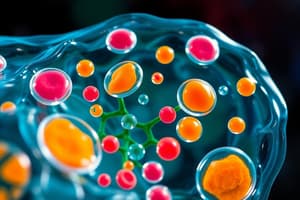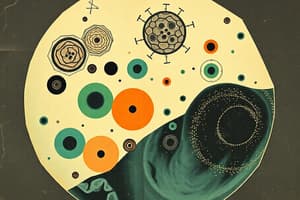Podcast
Questions and Answers
What is the function of the plasma membrane?
What is the function of the plasma membrane?
Controls the entry and exit of substances; enables intercellular communication; allows cells to recognize each other
What is the function of the nucleus?
What is the function of the nucleus?
Control center of the cell; regulates protein synthesis and chemical reactions
Which organelle is responsible for synthesizing proteins and transporting them to the Golgi apparatus?
Which organelle is responsible for synthesizing proteins and transporting them to the Golgi apparatus?
The ________________ manufactures lipids and carbohydrates, detoxifies harmful chemicals, and stores calcium.
The ________________ manufactures lipids and carbohydrates, detoxifies harmful chemicals, and stores calcium.
Signup and view all the answers
Simple diffusion involves substances moving freely through the lipid bilayer without the help of membrane transport proteins.
Simple diffusion involves substances moving freely through the lipid bilayer without the help of membrane transport proteins.
Signup and view all the answers
Match the type of diffusion with its description:
Match the type of diffusion with its description:
Signup and view all the answers
What is receptor-mediated endocytosis?
What is receptor-mediated endocytosis?
Signup and view all the answers
What are the steps involved in phagocytosis?
What are the steps involved in phagocytosis?
Signup and view all the answers
Exocytosis releases materials from outside the cell.
Exocytosis releases materials from outside the cell.
Signup and view all the answers
During ____, the plasma membrane folds inward and forms a vesicle containing a droplet of extracellular fluid.
During ____, the plasma membrane folds inward and forms a vesicle containing a droplet of extracellular fluid.
Signup and view all the answers
Match the following with their descriptions:
Match the following with their descriptions:
Signup and view all the answers
Study Notes
Cell Parts and Functions
-
Plasma Membrane: Composed of phospholipids and cholesterol, with proteins embedded or attached; controls entry and exit of substances and has receptor proteins for intercellular communication.
-
Nucleus: Enclosed by a double membrane with nuclear pores; contains chromatin and nucleolus; regulates protein synthesis and cell growth.
-
Cytoplasmic Organelles:
- Ribosome: Site of protein synthesis; found attached to endoplasmic reticulum or free in cytoplasm.
- Rough Endoplasmic Reticulum: Synthesizes proteins and transports them to Golgi apparatus.
- Smooth Endoplasmic Reticulum: Manufactures lipids, detoxifies chemicals, and stores calcium.
- Golgi Apparatus: Modifies, packages, and distributes proteins and lipids.
- Lysosome: Contains digestive enzymes for breaking down waste and foreign substances.
- Peroxisome: Breaks down fatty acids and amino acids, and detoxifies hydrogen peroxide.
- Proteasome: Breaks down proteins in the cytoplasm.
- Mitochondria: Generates energy for the cell through ATP synthesis.
- Centrioles: Organize microtubules during cell division and form cilia and flagella.
- Cilia: Moves substances along the cell surface.
- Flagellum: Propels sperm cells.
Fluid Mosaic Model
- Describes the plasma membrane as a fluid, dynamic structure with proteins and lipids.
Membrane Physiology
- Diffusion: Passive process where particles move from high to low concentration.
- Factors Affecting Diffusion Rate: concentration gradient, temperature, surface area, and diffusion distance.
Types of Diffusion
- Simple Diffusion: Non-polar molecules move through the lipid bilayer.
-
Facilitated Diffusion: Integral membrane proteins assist polar or charged molecules.
- Channel-Mediated Facilitated Diffusion: Ionic channels allow specific ions to pass through.
- Carrier-Mediated Facilitated Diffusion: Carrier proteins bind to molecules and change shape to transport them.
Active Transport
-
Primary Active Transport: Energy from ATP hydrolysis pumps substances against their concentration gradient.
- Sodium-Potassium Pump: Exchanges sodium ions for potassium ions to maintain cellular balance.
- Secondary Active Transport: Uses energy from ionic gradients to transport substances.
Endocytosis
- Receptor-Mediated Endocytosis: Specific binding of ligands to receptors, followed by vesicle formation and fusion with endosomes.
- Phagocytosis: Engulfing and breaking down large particles, such as bacteria, by phagocytes.
- Bulk-Phase Endocytosis (Pinocytosis): Ingestion of extracellular fluid and solutes.
Exocytosis
- Release of Materials: Vesicles fuse with the plasma membrane, releasing contents into the extracellular fluid.
Transcytosis
- Vesicular Transport: Vesicles move across the cell, releasing contents on the opposite side.
Osmosis
- Net Movement of Solvent: Water molecules move through a selectively permeable membrane from high to low concentration until equilibrium.
Principle of Osmosis
- Water Movement: Water molecules move down their concentration gradient through simple diffusion or aquaporins.
Osmotic Pressure and Tonicity
- Isotonic Solution: Equal concentration of solutes on both sides of the membrane.
- Hypotonic Solution: Lower solute concentration, causing water influx and cell swelling.
- Hypertonic Solution: Higher solute concentration, causing water efflux and cell shrinkage.
Studying That Suits You
Use AI to generate personalized quizzes and flashcards to suit your learning preferences.
Description
Learn about the different components of a cell, including the plasma membrane, nucleus, and cytoplasmic organelles, and their roles in cell function and growth.




